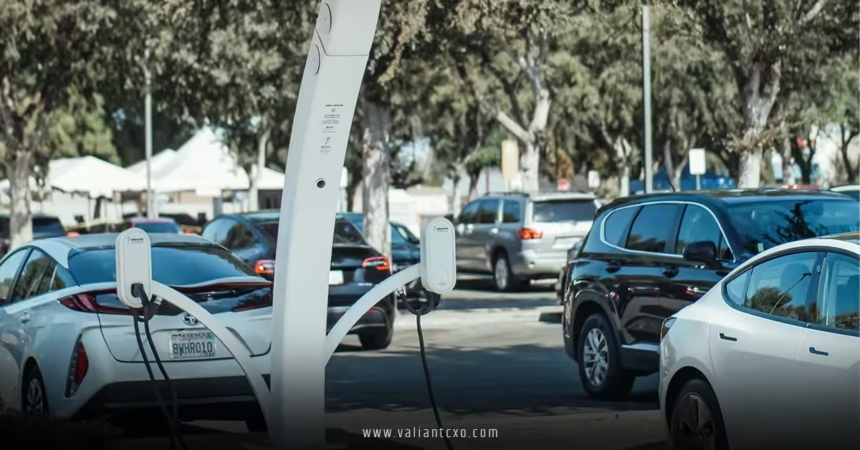Insurance Implications of the Growing EV Charging Network in America are reshaping how we think about car ownership, safety, and financial protection. Picture this: you’re cruising down the highway in your shiny new electric vehicle (EV), the hum of the motor barely audible, and you pull into a charging station. It’s convenient, eco-friendly, and part of America’s push toward a greener future. But have you ever stopped to wonder what happens if that charging station malfunctions, damages your car, or worse, causes an accident? As the EV charging network expands faster than a wildfire in a dry forest, the insurance industry is scrambling to keep up. This article dives deep into the Insurance Implications of the Growing EV Charging Network in America, exploring risks, coverage gaps, and what it all means for drivers, businesses, and insurers.
The EV Charging Boom: A New Frontier for Insurance
The rise of electric vehicles is no small trend—it’s a revolution. By 2030, experts predict there could be as many as 33 million EVs on U.S. roads, and with that comes a pressing need for charging infrastructure. The U.S. Department of Energy reported over 61,000 public charging stations as of early 2024, with numbers growing rapidly thanks to federal initiatives like the Infrastructure Investment and Jobs Act. But as charging stations pop up in urban hubs, rural outposts, and even retail parking lots, new risks emerge that insurance companies must address.
Why the Insurance Implications of the Growing EV Charging Network in America Matter
Imagine a charging station as a gas pump with a brain. It’s not just dispensing fuel—it’s a complex piece of tech that interacts with your vehicle, the power grid, and sometimes even your payment info. This complexity introduces risks that traditional auto insurance might not cover. From equipment malfunctions to cybersecurity threats, the Insurance Implications of the Growing EV Charging Network in America are vast and evolving. Insurers are now tasked with creating policies that protect drivers, station operators, and even utility companies from these unique challenges.
The Scale of the Charging Network Growth
The Biden administration has set a goal of 500,000 public charging ports by 2030, backed by billions in federal funding. Private companies like Tesla, ChargePoint, and Walmart are also jumping in, building networks to meet demand. This rapid expansion means more drivers are relying on public chargers, but it also means more opportunities for things to go wrong. Whether it’s a faulty charger frying your EV’s battery or a poorly maintained station causing a fire, the Insurance Implications of the Growing EV Charging Network in America are forcing insurers to rethink their approach.
Risks Associated with EV Charging Stations
The Insurance Implications of the Growing EV Charging Network in America stem from a variety of risks that didn’t exist in the era of gas-powered cars. Let’s break down the major ones and what they mean for insurance coverage.
Equipment Malfunctions and Vehicle Damage
Ever plugged your phone into a cheap charger only to find it overheating? Now imagine that happening to your $50,000 EV. Charging stations, especially fast chargers, deliver massive amounts of electricity, and a glitch could damage your vehicle’s battery or electrical system. Studies suggest that charging stations are only about 78% reliable, meaning one in five attempts might fail or cause issues. If a malfunction fries your EV, who’s on the hook? Your auto insurance? The station operator’s liability policy? The Insurance Implications of the Growing EV Charging Network in America include questions about who covers repair costs when equipment fails.
Fire and Electrical Hazards
High-voltage chargers are like lightning bolts in a box—they’re powerful but dangerous if mishandled. Poorly maintained stations or faulty wiring could spark fires, endangering drivers, nearby businesses, and even passersby. A single fire could lead to thousands in damages, not to mention potential injuries. Insurers are now looking at property damage and general liability policies to cover these risks, but gaps remain. The Insurance Implications of the Growing EV Charging Network in America mean businesses hosting chargers, like retailers or gas stations, may need specialized coverage to protect against these hazards.
Cybersecurity Threats
In a world where even your toaster can get hacked, EV charging stations are prime targets. Many stations connect to apps or payment systems, creating vulnerabilities for data breaches or remote tampering. Imagine a hacker manipulating a charger to overheat your EV or stealing your credit card info. The Insurance Implications of the Growing EV Charging Network in America now include cyber insurance for station operators and even drivers, as personal data becomes a hot commodity.
Public Safety and Liability
Charging stations in public spaces, like mall parking lots or highway rest stops, introduce new liability concerns. What if a poorly designed station causes a trip-and-fall accident? Or worse, what if a driver is injured due to a malfunction? The Insurance Implications of the Growing EV Charging Network in America extend to premises liability, where property owners must ensure their stations are safe and accessible. Without proper coverage, a single lawsuit could cripple a small business hosting a charger.
How Insurance Companies Are Adapting
The Insurance Implications of the Growing EV Charging Network in America are pushing insurers to innovate. Traditional auto and property policies weren’t designed for the unique risks of EV charging, so companies are rolling out new products and adjusting existing ones to fill the gaps.
Specialized EV Charging Insurance Products
Some insurers are now offering policies tailored to EV charging stations. These might cover equipment breakdowns, electrical fires, or even business interruption if a station goes offline. For example, companies like Chubb are exploring commercial policies that address the specific risks of EV infrastructure. For drivers, add-ons to auto policies can cover charger-related damage, ensuring you’re not left paying out of pocket for a fried battery.
Adjusting Auto Insurance for EV Owners
Your standard auto policy might cover collisions or theft, but what about charger-induced damage? Insurers are starting to offer endorsements for EV-specific risks, like battery damage from faulty chargers. The Insurance Implications of the Growing EV Charging Network in America mean you might need to double-check your policy to ensure it covers these scenarios. After all, replacing an EV battery can cost as much as a used car!
Cyber Insurance for Charging Networks
As charging stations become more connected, cyber insurance is gaining traction. Policies can protect against data breaches, ransomware, or even physical damage caused by hacked chargers. For businesses operating large networks, like ChargePoint, cyber coverage is becoming a must-have. The Insurance Implications of the Growing EV Charging Network in America highlight the need for robust cybersecurity measures to keep both drivers and operators safe.
Liability Coverage for Property Owners
If you own a retail store with a charging station, you’re not just selling coffee or groceries—you’re now in the energy business. Property owners need liability coverage to protect against accidents or injuries at their stations. The Insurance Implications of the Growing EV Charging Network in America mean that businesses must work closely with insurers to assess risks and secure adequate coverage.
Economic Impacts and Insurance Opportunities
The Insurance Implications of the Growing EV Charging Network in America aren’t just about risks—they’re also about opportunities. The expansion of charging infrastructure is creating new revenue streams for businesses and insurers alike.
Boosting Local Economies
A study from MIT found that installing a charging station can boost nearby business spending by up to 3.2% when within 100 meters. Drivers charging their EVs often grab a coffee, shop, or eat while they wait, turning charging stations into economic hubs. For insurers, this means more businesses needing commercial policies to cover their stations, creating a new market for tailored products. The Insurance Implications of the Growing EV Charging Network in America are driving economic growth, but they also require businesses to be proactive about risk management.
Opportunities for Insurers
The growing EV charging network is a goldmine for insurers willing to innovate. By developing specialized policies for station operators, property owners, and EV drivers, insurance companies can tap into a booming market. The Insurance Implications of the Growing EV Charging Network in America are pushing insurers to think creatively, offering products that address everything from equipment breakdowns to cyber threats.
Challenges in Insuring the EV Charging Network
While opportunities abound, the Insurance Implications of the Growing EV Charging Network in America come with challenges. The rapid pace of growth, combined with the novelty of EV technology, creates uncertainty for insurers.
Lack of Historical Data
Insurance is all about predicting risk, but with EV charging stations, there’s not much history to go on. Unlike gas stations, which have decades of data on accidents and claims, EV chargers are relatively new. This lack of data makes it hard for insurers to set premiums or predict losses, leading to higher costs for policyholders. The Insurance Implications of the Growing EV Charging Network in America include the need for insurers to gather real-world data to refine their models.
Uneven Distribution of Chargers
Charging stations aren’t spread evenly across the U.S. Urban areas like California have far more chargers than rural regions, creating “charging deserts” in some places. This uneven distribution affects insurance risk—urban stations face higher usage and potential for accidents, while rural stations might see less wear but higher maintenance costs. The Insurance Implications of the Growing EV Charging Network in America require insurers to tailor policies to different regions and usage patterns.
Regulatory and Standardization Issues
The EV charging industry is a bit like the Wild West—everyone’s doing their own thing. Tesla’s North American Charging Standard (NACS) is gaining traction, but not all chargers are compatible with all EVs. This lack of standardization can lead to confusion and even accidents, complicating insurance claims. The Insurance Implications of the Growing EV Charging Network in America mean insurers must stay on top of evolving standards to ensure their policies remain relevant.
What Drivers Need to Know
For EV owners, the Insurance Implications of the Growing EV Charging Network in America are a wake-up call. Here’s what you need to do to protect yourself.
Review Your Auto Policy
Before you plug into a public charger, check your auto insurance policy. Does it cover damage from a faulty charger? What about theft of your charging cable? Some insurers, like Progressive, offer EV-specific endorsements that can fill these gaps. Don’t get caught off guard—make sure your coverage matches the risks of the growing charging network.
Be Cautious with Public Chargers
Not all charging stations are created equal. Look for well-maintained stations from reputable providers, and avoid chargers that look damaged or outdated. The Insurance Implications of the Growing EV Charging Network in America mean that a little caution can save you from costly repairs or insurance headaches.
Understand Your Rights
If a charging station damages your EV, you may be able to file a claim against the station operator’s liability policy. Keep records of your charging session, including receipts or app logs, to support your claim. The Insurance Implications of the Growing EV Charging Network in America give you options, but you need to know how to navigate them.
The Future of EV Charging and Insurance
The Insurance Implications of the Growing EV Charging Network in America will only become more complex as the network expands. Emerging technologies like vehicle-to-grid (V2G) systems, which let EVs feed power back to the grid, could introduce new risks and opportunities. Insurers will need to adapt to cover these innovations, while drivers and businesses must stay informed to protect themselves.
The Role of Regulation
Government policies, like the National Electric Vehicle Infrastructure (NEVI) program, are shaping the charging landscape. As regulations evolve, insurers will need to align their products with new standards for safety and interoperability. The Insurance Implications of the Growing EV Charging Network in America will depend heavily on how these regulations develop.
A Collaborative Approach
The future of EV charging insurance will require collaboration between insurers, automakers, station operators, and policymakers. By working together, they can create a robust system that supports EV adoption while managing risks. The Insurance Implications of the Growing EV Charging Network in America are a call to action for all stakeholders to build a safer, more reliable charging ecosystem.
Conclusion
The Insurance Implications of the Growing EV Charging Network in America are as dynamic as the EV revolution itself. From equipment malfunctions to cybersecurity threats, the risks associated with charging stations are pushing insurers to innovate and adapt. For drivers, it’s a reminder to review your policies and stay cautious when plugging in. For businesses, it’s an opportunity to tap into a growing market while managing new liabilities. As America races toward a future with millions of EVs on the road, understanding these insurance implications is crucial. So, whether you’re an EV owner, a business hosting a charger, or just curious about the future, now’s the time to get informed and stay ahead of the curve. Let’s embrace the electric future with confidence, knowing we’re covered for whatever comes next.
FAQs
1. How do the Insurance Implications of the Growing EV Charging Network in America affect my auto insurance rates?
The Insurance Implications of the Growing EV Charging Network in America could lead to higher rates if your policy includes EV-specific coverage for risks like charger-related damage. However, rates vary by insurer, so shop around for policies tailored to EVs.
2. Can a faulty EV charger damage my vehicle, and who covers it?
Yes, a malfunctioning charger can harm your EV’s battery or electrical system. The Insurance Implications of the Growing EV Charging Network in America mean your auto insurance might cover repairs, but you may also file a claim against the station operator’s liability policy.
3. Do businesses need special insurance for hosting EV charging stations?
Absolutely. The Insurance Implications of the Growing EV Charging Network in America include the need for commercial liability and property coverage to protect against accidents, fires, or equipment failures at charging stations.
4. Are cybersecurity risks a concern for EV charging stations?
Yes, hackers could target connected chargers to steal data or cause damage. The Insurance Implications of the Growing EV Charging Network in America highlight the growing need for cyber insurance to protect both drivers and operators.
5. How can I ensure my EV is protected when using public chargers?
Check your auto policy for EV-specific coverage, use reputable charging stations, and keep records of your charging sessions. The Insurance Implications of the Growing EV Charging Network in America make it essential to be proactive about your protection.
For More Updates !! : valiantcxo.com


